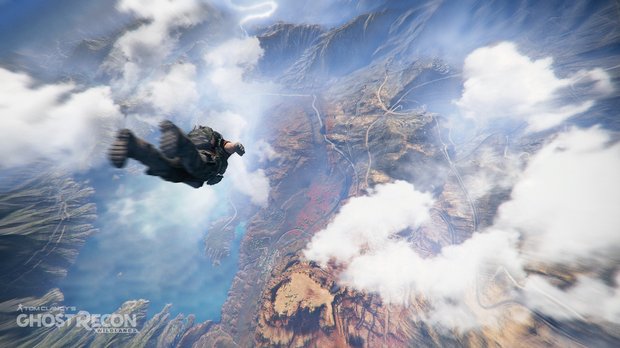There are two schools of thought on Wildlands. One says it’s a brash GTA wannabe that betrays Ghost Recon’s grounding in team-based tactical warfare. The other side argues it’s a much-needed modernisation of a flagging series; one that transplants the action into an exotic, reactive open world, where stealthy stake-outs are still on the menu, but players have the agency to blaze a louder trail to their objective.

It’s important then I make clear which side of that divide I fall on, because while I loved what I saw behind closed doors at E3, Wildlands is going to upset as many hardened Tom Clancy fans as it captivates. And, sorry traditionalists, but I fall firmly on the side of the debate that allows us to commandeer a drug baron’s car, escape a high-octane chase by rocketing off a piece of corrugated iron jutting out from a canyon edge, and then nail a perfect landing on a salt plain below, where I can extract our gung-ho asses to the next mission by chopper. Yeaaah! So ask yourselves before I begin: are you in or out?
Divisive Wildlands might prove to be, but the view from a helicopter is majestic enough to hush the most ardent critics. The open world environment, I'm told as we thunder over peaks and troughs, is the largest in any Ubisoft game to date – a vast, rugged playground that stretches across the Andes in Bolivia. Usually the trend for open-world games such as this is to show us how ‘teeming with life’ they are, but Wildlands is different by design – the endless, maddening desertscape is punctuated only by tiny pockets of life and colour that flourish in the areas where the mountains peter out, where the ground is arable enough to allow villages to spring up from the dust. It’s an arid world, but one fertile with opportunities to raise hell.

With your head in the clouds, these villages appear as mere specks in the landscape, but youcan see that there are over a hundred, each packed with objectives that players can tackle in any order they fancy (or so it would appear). The player in the chopper decides to inspect one at ground level (via base jumping, because apparently Wildlands is happy to invite Just Cause 3 comparisons) and up close, you learn that these settlements are typical South American riots of bustle. While some are naturally sleepier than others, there’s usually something kicking off that draws your senses as you explore on foot.
In the rustic village on my screen, the entire community had spilled out onto the streets to explore a farmer’s market. My eyes dart to one of the other screens in the room – in all, the four players are co-habiting the game world, but are spread miles apart, left to their own devices. In one, I see a town enthralled by a local concert. On another screen, less harmonious scenes play out, as members of a drug cartel rough up some locals and hold them hostage. They’re why you’re here in the first place – Bolivia, in Wildlands’ fiction at least, is the world’s biggest cocaine producer, and the Santa Blanca gang are the country’s de facto rulers. By completing missions, you weaken the ties between the cartel and the corrupt government, and strangle the supply line that’s piping cocaine to the world. Tantalisingly, it seems you can do bad as well as good – I later witnessed a massacre that, I was told, was a direct consequence of a mission that had been completed earlier.

Back on my screen I launch into a mission, and all four players converge on a small mining town called Huertas, on a job to track down a high-ranking smuggler named Luis ‘El Chango’ Alvarez – who is willing to sell intel on his boss. His snitching nature hasn’t exactly gone unnoticed however, which is why he currently finds himself locked in a cage. It takes a while for all four of us to arrive – early birds set up vantage points in the hills, waiting for stragglers to arrive fashionably late.
Missions are unscripted and players begin each one wherever and however they like. And within this footloose structure, the lopsided composition of Wildlands’ open world of crowded urban areas surrounded by huge expanses of nothingness suddenly makes sense. The cleanest way to take out the guards surrounding El Chango’s prison is to snipe from afar – the mountain ranges overlooking the town are an embarrassment of camping riches. But then, things get messy if you have to swoop in and collect something after raising the alarm, and besides, this approach also denies you the chance to squeeze valuable intel from footsoldiers on the ground, Sam Fisher style. Here’s where a little local knowledge comes into play – how heavily guarded is the city (in Huertas’ case, very), and what distractions can you use to ghost unseen to your target?
Weekly digests, tales from the communities you love, and more
Once we spring El Chango from his cage, we’re grateful to be only a minute’s drive from the wilderness. After springing El Chango’s head against a drug baron car’s to ensure his continued co-operation, we steal the ride and burn off towards the edge of a canyon, with half of Santa Blanca in pursuit. Things look bleak until we spy a piece of corrugated iron glistening in the distance. We change direction, and… well, you already know the rest. So, that’s how it works. Only one question remains: are you in or out?
Click here for more excellent Official Xbox Magazine articles. Or maybe you want to take advantage of some great offers on magazine subscriptions? You can find them here.



